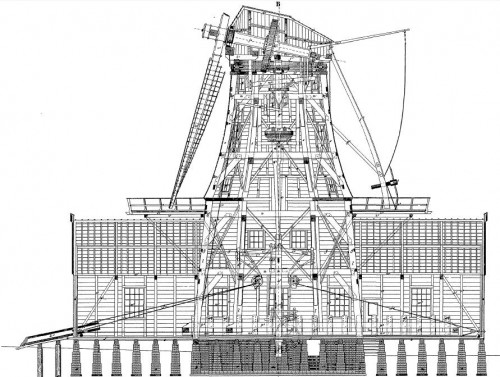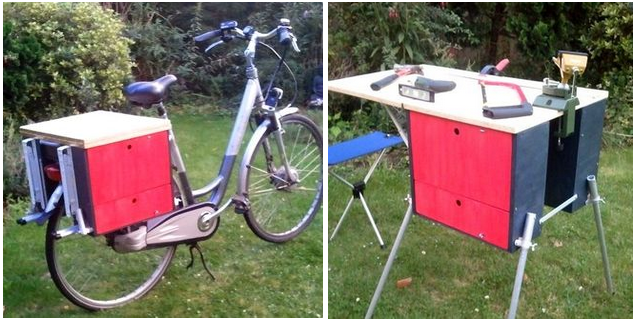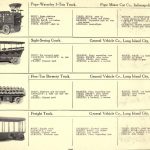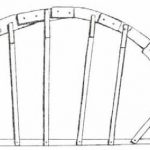“Resawing is the technique of ripping boards across their width to make thinner boards. It’s useful for making things like drawer sides, box dividers, custom veneers, or slices for bent wood laminations. This is the alternative to planing thicker stock down, which wastes a lot of wood.” Read more.
Building Plans for Dutch Industrial Windmills (1850)
This collection of 21 building plans for 5 different types of Dutch industrial windmills was published in 1850. There is a saw mill, an oats mill, a flour mill, and two pumping mills. The book contains no text, only illustrations.
“Theoretisch en practisch molenboek: voor ingenieurs, aannemers, molenaars en andere bouwkundigen“, G. Krook, 1850.
(“Theoretical and practical windmill book; for engineers, contractors and millwrights”).
How to Carry a Foldable Workshop on The Rear Rack of Your Bicycle
Instruction manual. Thanks to Berto Aussems.
Finally: A Life Cycle Analysis of Electric Cars
“We develop and provide a transparent life cycle inventory of conventional and electric vehicles and apply our inventory to assess conventional and EVs over a range of impact categories. For all scenarios analyzed, the use phase is responsible for the majority of the global warming potential (GWP) impact, either directly through fuel combustion or indirectly during electricity production.”
Total emissions
“When powered by average European electricity, EVs are found to reduce GWP by 20% to 24% compared to gasoline ICEVs and by 10% to 14% relative to diesel internal combustion engine vehicles (ICEVs) under the base case assumption of a 150,000 km vehicle lifetime. When powered by electricity from natural gas, we estimate EVs offer a reduction in GHG emissions of 12% compared to gasoline ICEVs, and break even with diesel ICEVs. EVs powered by coal electricity are expected to cause an increase in GWP of 17% to 27% compared with diesel and gasoline ICEVs. Wind power electricity would allow electric transportation with life cycle carbon footprints as low as 106 g CO2-eq/km.”
Vehicle production: Manufacturing one electric car takes as much energy as manufacturing two conventional automobiles
“In contrast with ICEVs, almost half of an EV’s life cycle GWP is associated with its production. We estimate the GWP from EV production to be 87 to 95 grams carbon dioxide equivalent per kilometer (g CO2-eq/km), which is roughly twice the 43 g CO2-eq/km associated with ICEV production. Battery production contributes 35% to 41% of the EV production phase GWP, whereas the electric engine contributes 7% to 8%. Other powertrain components, notably inverters and the passive battery cooling system with their high aluminum content, contribute 16% to 18% of the embodied GWP of EVs.”
“Comparative Environmental Life Cycle Assessment of Conventional and Electric Vehicles“, Troy R. Hawkins, Bhawna Singh, Guillaume Majeau-Bettez, Anders Hammer Strømman, in “Journal of Industrial Ecology”, October 2012. Via the BBC and Treehugger. Picture: Trexa. Previously: The status quo of electric cars: better batteries, same range.
Cargo Cycles Database
Yes, it’s written in German. But nowhere else will you find such a complete database showing and describing all cargo cycles available on the market today.
Moreover, the information is easy to navigate and you can consult the specifications of the vehicles without even a basic knowledge of foreign languages. The description of most models also includes a link to the website of the manufacturer. Check out the Nutzrad Cargo Cycle Database.
Read more:
Cargo cyclists replace trucks drivers on European city streets.
Make Your Own Treadle Lathe
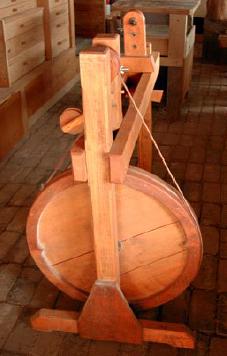 In the last twenty years or so since I built this foot-powered treadle lathe, I have received many requests for drawings or plans.
In the last twenty years or so since I built this foot-powered treadle lathe, I have received many requests for drawings or plans.
The lathe has been used as part of our traditional woodworking demonstrations and it never fails to draw a crowd. Of course, the reason the lathe exists is because I felt a need for it as a tool.
Some of the main considerations when designing the lathe were:
- Human powered — our solar energy system was pretty small at the time
- Size — it had to be less than 42″ tall to fit into our old truck
- Compact — since it would sit in our small shop all the time, a small footprint was essential
- Portable — as in not too cumbersome or heavy
- Functional — it had to perform the basic duties of a light-duty lathe
- Adaptable — I had in mind several untraditional uses for the tool, like sanding”
